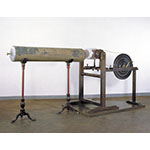Frictional electrical machine with a glass cylinder rotated by a large pulley wheel supported in such a way that it can be easily adjusted to keep the leather pulley cord taut. The large leather cushion is secured to a mahogany backplate supported by two flexible wooden strips, insulated by two thick horizontal glass rods. The prime conductor consists of a large wooden and canvas tube, on two wooden and glass supports mounted on tripods. The negative conductor has a turned wooden base covered with tin foil, an upright wooden and canvas tubular support also covered with tin foil, and a sliding electrode arrangement (replacement).
Twelve-inch long sparks could be generated—in modern terms, c. 170,000 volts. The generator was custom-made for Peter Leopold. The Grand Duke was so pleased with it that, in December 1774, he awarded a special gold medal and the sum of 1,415 Tuscan lire to its maker, Edward Nairne. The large battery of Leyden jars supplied with the machine is now lost. An engraving in the Philosophical Transactions of the Royal Society of 1774 shows the machine ready for experiments. Provenance: Lorraine collections.










